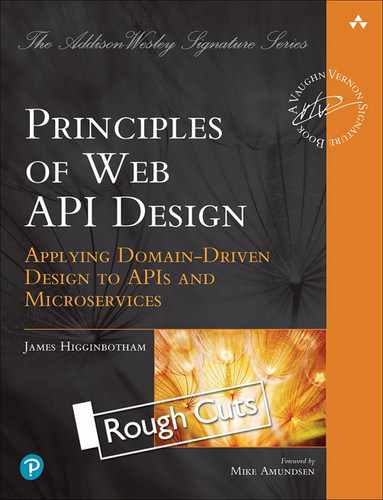Principles of Web ADI Design is a comprehensive, start-to-finish guide to the processes required for effective API design. Unlike other books, it covers the entire lifecycle. Leading API and microservices consultant James Higginbotham shows how API development teams can successfully integrate processes that occur before, during, and after API design, to scale API development far beyond single individuals or small teams. Higginbotham addresses REST in depth while also fully covering RPC and graph-based API design, as well as messaging, streaming, and event-based async APIs. Coverage includes The art of API design, and an overview of the API design process Crafting job stories, conducting EventStorming sessions, and modeling API capabilities Designing APIs that can easily evolve Implementing APIs, and moving to microservices Improving API quality through effective testing, documentation, and protection mechanisms Establishing and maturing your API program: leveraging program and data management techniques that scale
Table of Contents
- Cover Page
- Title Page
- Contents
- Table of Contents
- Preface
- About the Author
- I: Introduction to Web API Design
- 1. The Principles of API Design
- The Elements of Web API Design
- API Design Is Communication
- Reviewing the Principles of Software Design
- Resource-Based API Design
- The Principles of Web API Design
- Summary
- 2. Collaborative API Design
- Why an API Design Process?
- API Design Process Anti-Patterns
- The API Design-First Approach
- Remaining Agile with API Design-First
- The Align-Define-Design-Refine Process
- The Role of DDD in API Design
- API Design Involves Everyone
- Applying the Process Effectively
- Summary
- II: Aligning on API Outcomes
- 3. Identify Digital Capabilities
- Ensuring Stakeholder Alignment
- What are Digital Capabilities?
- Focusing on the Jobs to be Done
- What are Job Stories?
- The Components of a Job Story
- Writing Job Stories for APIs
- Overcoming Job Story Challenges
- Techniques for Capturing Job Stories
- A Real-World API Design Project
- Job Story Examples
- Summary
- 4. Capture Activities and Steps
- Extending Job Stories into Activities and Steps
- Using EventStorming for Collaborative Understanding
- How EventStorming Works
- The Benefits of EventStorming
- Facilitating an EventStorming Session
- Summary
- III: Defining Candidate APIs
- 5. Identifying API Boundaries
- Avoiding API Boundary Anti-Patterns
- Bounded Contexts, Subdomains, and APIs
- Finding API Boundaries Using EventStorming
- Finding API Boundaries Through Activities
- Naming and Scoping APIs
- Summary
- 6. API Modeling
- What is API Modeling?
- The API Modeling Process
- Validating the API Model with Sequence Diagrams
- Evaluating API Priority and Reuse
- Summary
- IV: Designing APIs
- 7. REST-Based API Design
- What is a REST-based API?
- REST API Design Process
- Selecting a Representation Format
- Common REST Design Patterns
- Summary
- 8. RPC and Query-Based API Design
- What is an RPC-based API?
- RPC API Design Process
- What is a Query-Based API?
- Query-Based API Design Process
- Summary
- 9. Async APIs for Eventing and Streaming
- The Problem with API Polling
- Async APIs Create New Possibilities
- A Review of Messaging Fundamentals
- Async API Styles
- Designing Async APIs
- Documenting Async APIs
- Summary
- V: Refining the API Design
- 10. From APIs to Microservices
- What Are Microservices?
- Microservices Reduce Coordination Costs
- The Difference Between APIs and Microservices
- Weighing the Complexity of Microservices
- Synchronous and Asynchronous Microservices
- Microservice Architecture Styles
- Right-Sizing Microservices
- Decomposing APIs Into Microservices
- Considerations When Transitioning to Microservices
- Summary
- 11. Improving the Developer Experience
- Creating a Mock API Implementation
- Providing Helper Libraries and SDKs
- Offering CLIs for APIs
- Summary
- 12. API Testing Strategies
- Acceptance Testing
- Automated Security Testing
- Operational Monitoring
- API Contract Testing
- Selecting Tools to Accelerate Testing
- The Challenges of API Testing
- Make API Testing Essential
- Summary
- 13. Document the API Design
- The Importance of API Documentation
- API Description Formats
- Extending Docs with Code Examples
- From Reference Docs to a Developer Portal
- Effective API Documentation
- The Minimum Viable Portal (MVP)
- Tools and Frameworks for Developer Portals
- Summary
- 14. Designing for Change
- The Impact of Change on Existing APIs
- API Versioning Strategies
- Deprecating APIs
- Establishing an API Stability Contract
- Summary
- 15. Protecting APIs
- The Potential for API Mischief
- Essential API Protection Practices
- Components of API Protection
- API Gateway Topologies
- Identity and Access Management (IAM)
- Considerations Before Building an In-House API Gateway
- Summary
- 16. Continuing the API Design Journey
- Establishing an API Style Guide
- Conducting API Design Reviews
- Developing a Culture of Reuse
- The Journey Has Only Begun
- Appendix A. HTTP Primer
